Where to get the air conditioning water drain: norms and options for the drainage system for a split system
The eternal headache of installers and designers: where to drain the air conditioning water. Nobody is happy with installing a duct with a drainage through the entire wall, the neighbors from below complain of round-the-clock dripping water from the drainage hose. Agree, this issue deserves a more worthy solution.
You will learn all about issues of education, collection and discharge of condensate that accompanies the operation of a household split-system from the article we presented. We will talk about how to better dispose of it with minimal inconvenience to yourself and others. Consider the recommendations for installing the drainage hose and methods for its output.
The content of the article:
- Causes of condensation and discharge paths
- Health Impact Assessment
- Condensate drain options
- Condensate drain pipes
- Check valve for climate system
- How to choose a siphon?
- Installation of a drainage system
- Drainage circuit maintenance
- Checking for condensate drainage
- Water Discharge Standards
- Conclusions and useful video on the topic
Causes of condensation and discharge paths
Warm air from the room enters the cooling radiator of the heat exchanger. There, when it cools, it “gives up” all the moisture contained in it. The principle of condensation can be demonstrated with a simple example. If you take any item out of the refrigerator, then it will immediately become covered with droplets of water. This is condensate.
The amount of condensate depends on humidity. The wetter the air, the more it will be released as a result of condensation. Please note that bacteria in dry air multiply much faster, which can cause respiratory illness. When the air conditioner is running, the room should be ventilated more often.
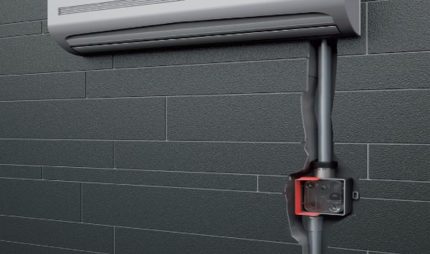
Why do we need condensate drain from the air conditioner:
- Since condensate is mainly water, and air conditioning is a complex electromechanical device, their proximity can lead to a situation with a short circuit and premature breakdown of equipment.
- In just one day, one air conditioner can dispense 20 liters of condensed liquid. And from the office center a whole ton will easily come together. This is a serious risk of flooding the basement.
- In stagnant water, mold, bacteria and other pathogens develop rapidly.
The arguments provided are enough to understand how important it is to properly organize a drainage system to divert water from the air conditioner.
Health Impact Assessment
The danger of condensation lies not only in the probable flooding or breakdown of the air conditioner itself. The main threat is harm to health. There are several factors that contribute to the comfortable growth of bacteria: heat, dirt and water. What are not ideal conditions for the development of various diseases?
Black mold fungi can cause many serious diseases, including cancer. Bacteria often cause pneumonia. Mortality from “legionnaire’s disease” is very high.
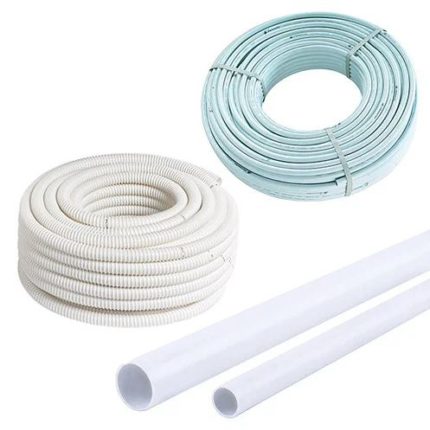
The disgusting smell is the smallest of all evils. The appearance of an unpleasant odor clearly signals the owner climate systemthat a thorough cleaning of the drainage is required.
Condensate drain options
There are several options for removing drainage of air conditioners, excluding split system flow into the room she is processing.
Method # 1: Drain into the street
A hole is drilled through a window or wall through which a hose is passed. On the one hand, the tube is connected to the nozzle in the bath located under the evaporator, and on the other, it hangs freely on the street.
Drainage to the street has its drawbacks:
- A hose hanging from a wall can impair the exterior presentation of a building, which is especially true for private homes.
- Water will constantly drip from the hose, if it gets into the outflow of neighbors from below it can lead to scandal.
However, due to the simplicity of the work, this method is the most common.
Method # 2: Disposal in the sewer
The connection of the drain pipe to the sewer will be an excellent option for many rooms. A traditional problem is the lack of a sewer in an air-conditioned room.
Solution to the problem:
- In a room with air conditioning, drainage pipes with a slope are installed.
- Installation of drainage pipes with a minimum slope to the nearest section with sewage.
An installer laying the air conditioner's path must have experience in carrying out such work.
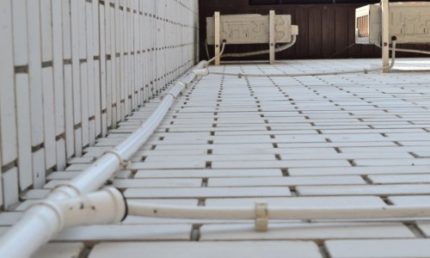
If it is not possible to ensure the required slope along the entire length of the pipeline, a special drainage pump is used. With its help, the condensate can be raised to the required height for further discharge by gravity.
Condensate drain pipes
Condensate is drained from the air conditioner through the drain pipes. Pipes used in the organization of condensate removal from the air conditioner can be made of polyvinyl chloride or polyethylene. Products made of these materials have high strength and are not susceptible to water.
Manufacturers of air conditioners complete their goods with tubes of two types - corrugated and smooth. The latter are found only in budget models of air conditioners and cannot be installed without special fittings.
You can use smooth pipes to organize a drainage pipeline, but only if the air conditioner is located close to the sewer. If the place of connection to the sewage system is far, then the installation will be greatly complicated due to the use of fittings.
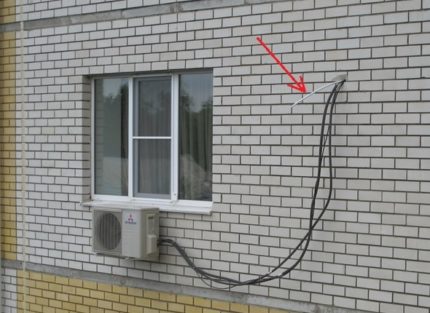
Due to the high flexibility of the corrugated tubes, fittings are not needed when installing the drainage pipeline. Polymer corrugation drain pipe for condensate drain from the outdoor and indoor units can be bent at any angle. The process of installing such a pipeline does not take you much time and effort.
Check valve for climate system
When connected to the sewer system, the water is discharged from the air conditioner through a drainage hose. Installing a non-return valve for the air conditioner will prevent odors from entering the apartment. It will leak liquid and prevent odors from entering in the opposite direction.
An ordinary siphon equipped with a water seal is distinguished by a U-shaped configuration. Water remains in the knee, which prevents the exit of sewer gases. So, when operating plumbing devices, there is a constant replacement of water in the hydraulic lock, so that its level does not change.
Since condensed water flows unevenly during the operation of the air conditioner, the water trap can dry out and gases will freely enter the room.
The way out will be the installation of a check valve for drainage of the split system. Sewage from sewage and air will be blocked, without creating any obstacles to condensate. The locking mechanism is a spring membrane or ball made of ABS.
When water enters the unit, the ball rises, giving access to the sewer. After the liquid leaves, it will fall under its own weight, blocking the hole.
How to choose a siphon?
Siphons designed to drain condensate have structural differences.
When choosing, the following criteria should be considered:
- Estimate the free space for installing the device. The dimensions of the selected model may simply not fit in an accessible area.
- The diameter of the outlet pipe. The dimensions of the inlet of the siphon and the drain hose must be the same.
- The tightness of the connection is ensured by rubber seals. When mounting the siphon in direct sunlight, they will quickly become worthless. In some cases, you will have to perform a hidden installation.
The amount of condensate must match the capacity of the unit. All necessary information is indicated in the characteristics of the devices. If the air conditioner produces a large amount of condensate, a high-capacity siphon is required.
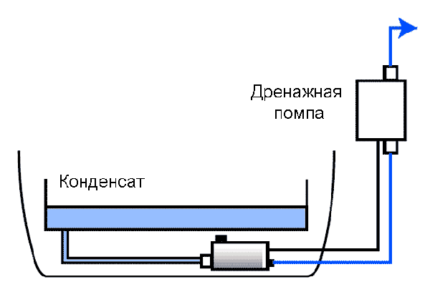
When choosing a built-in siphon, the depth of the niche for its installation is taken into account.
Installation of a drainage system
To begin with, you will have to draw up a layout of each element of the drain system.
It includes:
- clamps and fasteners;
- drainage tube;
- seals and adapters;
- siphon (if the drain pipe cannot be bent);
- sewage pipe.
A small slope of the sewer pipe brought to the sewer itself should be arranged in advance. Installing a siphon will allow you to create a water trap that prevents the access of gases from the sewer.
Since the air conditioner only works in the heat, a possible solution would be to install a check valve between the equipment and the sewer. It will be effective at any time of the year.Even if the water in the hydraulic lock dries, there will be no extraneous odors.
There are times when it is impossible to organize a gravity flow system. The output is the use of special containers in which condensate accumulates. As it accumulates, the tank spontaneously releases or is emptied using a pump.
To operate the drainage with the pump, an electrical connection is required. In this case, you can do without installing a check valve. The tube from the air conditioner enters the tank without a direct connection to the sewer.
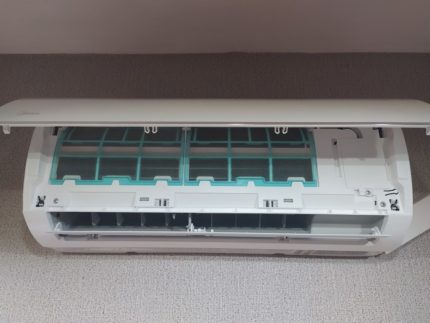
When installing the drainage of an air conditioner with a drain into the sewer, a horizontal section of the system should be organized and connected to a pipe coming from the receiving bath. If the distances are too long, you will have to make holes in the walls for the pipeline.
A large number of turns can cause blockages. Short piping is easier to maintain and clean.
Drainage circuit maintenance
After installing the condensate drainage system, it is necessary to take care of its functional state. There are many malfunctions that occur during operation and require immediate intervention.
Problem. Most often, a hole is clogged through which moisture is discharged into the drainage tube. The reason is dust and dirt accumulating in the hole. Debris settles and clogs the pipe. The bath is filled with liquid and it begins to flow along the walls to the floor.
Decision. To avoid unpleasant consequences, regularly clean and rinse the tube. For washing, detergents that contain chlorine are suitable, since it copes with the task as efficiently as possible.
Problem. If the pressure regulator is faulty, ice build-up may appear on the evaporator. The reason for this is the decrease in temperature on the street, and as a consequence, the temperature of freon.
Decision. To prevent malfunctions, regular inspection of the condensate drain paths from the split system should be carried out regularly.
Problem. If the air conditioner is turned on for heating in winter, the moisture drain pipe will quickly freeze, which will cause a breakdown.
Decision. If the outside temperature is below zero, the split system should be turned off. You can buy a low-temperature kit designed to heat the compressor and drain pipe. In this case, the air conditioner can work even at a temperature of -25 degrees.
Problem. Oversupply or lack of refrigerant can cause icing on the pipes and evaporator. The ice will melt and drain onto the floor.
Decision. Do not forget to monitor the level of refrigerant. Timely contact the service center for refueling.
Problem. If the pump breaks down, the drainage system fails.
Decision. It is better to purchase equipment from official suppliers and take responsibility for installation.
Problem. An incorrect angle of inclination of the drainage tube will cause stagnation of water. In the future, it will drip onto the floor.
Decision. Follow the recommendations for creating a tilt at the installation stage.
Checking for condensate drainage
If condensation does not drain from the drainage tube, and there is no desire to wait until the water flows from the indoor unit, you can do the diagnosis of the drainage system yourself.
Work on finding a problem is carried out in the following order:
- The air conditioner is disconnected from the power supply, the plug is removed from the outlet.
- Remove the top panel from the air conditioner. It is held on latches. Removed with a slight upward movement.
- Open the case on the indoor unit. It is fixed either on latches or on screws.
- After removing the cover, access to the tray under the radiator appears - condensation is collected here.
- A glass of water is poured into the condensate collecting tank and it is monitored to see if it exits from the other side of the drainage channel. If the water never appeared, it means that the drainage line is clogged.
The drain hose may be pushed or in the wrong position. As a result, the liquid cannot rise for free exit.
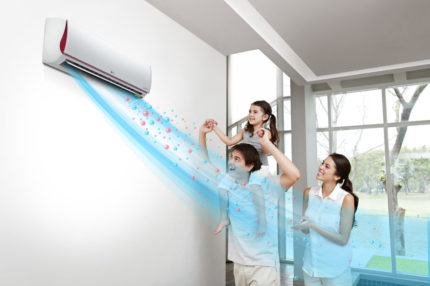
So you can simply check the drainage with gravity. With a pump installed to pump water from the tray, this method of checking the drainage path will not work.
Water Discharge Standards
There are norms for the drainage of water from the SanPiN air conditioner, which prohibits the discharge of condensate to the street. It is recommended that condensate be diverted to the sewer system. In this way, unwanted effects of moisture deposition on the air conditioner evaporator can be avoided.
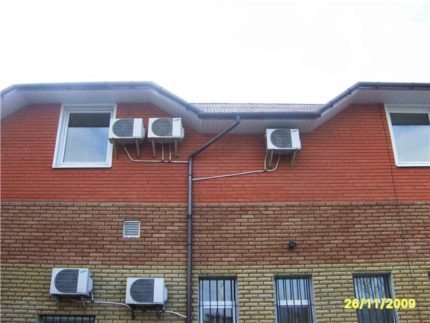
The frequency of servicing the drainage of the air conditioner depends on the correct installation of the condensate drainage system. Use more expensive tubes that do not change their internal shape when bent. Thus, you can build a reliable system with unimpeded movement of condensate to the outlet.
Conclusions and useful video on the topic
The following video will introduce the features of the device of the drainage system condensed during operation of the air conditioner to the following video:
During the installation of HVAC equipment, it is necessary to take into account the features of the air conditioning drainage device. If the pipes of the split system were correctly laid and a water seal was installed, the operation of the unit will not cause any inconvenience. Where to dispose of condensate, it is better to decide at the stage of designing the route and the location of the blocks.
Want to talk about your own experience in organizing drainage for HVAC equipment? Have information on an interesting and practical solution to the problem? Leave comments, please, in the block form below, ask questions, share impressions and photos on the topic of the article.

 What is a channel split system: varieties and device options
What is a channel split system: varieties and device options  How to build an air conditioner route: communications device specifics
How to build an air conditioner route: communications device specifics  Condensate drainage from the outdoor unit of the air conditioner: organization methods and best technological solutions
Condensate drainage from the outdoor unit of the air conditioner: organization methods and best technological solutions  Proper use of split systems: operation of equipment + tips for care
Proper use of split systems: operation of equipment + tips for care 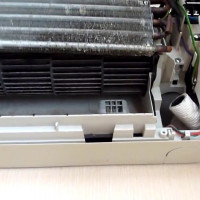 The device of the indoor unit split system: how to disassemble equipment for cleaning and repair
The device of the indoor unit split system: how to disassemble equipment for cleaning and repair 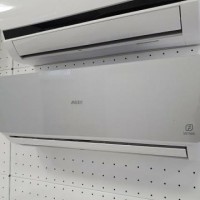 Errors of Aux conditioners: how to identify a malfunction and restore the operation of the split system
Errors of Aux conditioners: how to identify a malfunction and restore the operation of the split system  How much does it cost to connect gas to a private house: the price of organizing gas supply
How much does it cost to connect gas to a private house: the price of organizing gas supply  The best washing machines with dryer: model rating and customer tips
The best washing machines with dryer: model rating and customer tips  What is the color temperature of light and the nuances of choosing the temperature of the lamps to suit your needs
What is the color temperature of light and the nuances of choosing the temperature of the lamps to suit your needs  Replacement of a geyser in an apartment: replacement paperwork + basic norms and requirements
Replacement of a geyser in an apartment: replacement paperwork + basic norms and requirements